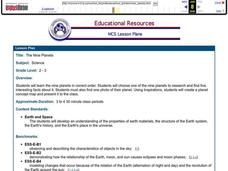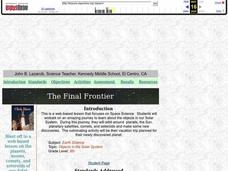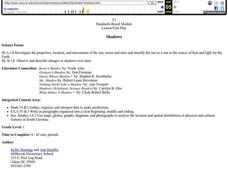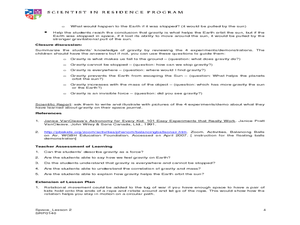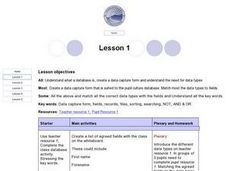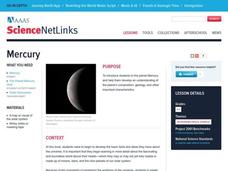Curated OER
Location
Students explore the tools used by Columbus to chart his latitude. They study the change of a location over time.
Curated OER
On The Day You Were Born
Students engage in a study about the holiday of a birthday with the help of using children's literature. They make cognitive connections of using the characters of the book and relating them to the personal celebration of a birthday.
Curated OER
Our Place in Space
Third graders identify the different planets that make up the solar system. In this space science lesson, 3rd graders construct a scale model of the major planets. They explore their different unique features and dress up as planets.
Curated OER
Crossword: Solar System
In this crossword instructional activity, students complete a crossword puzzle by solving clues about the solar system. For example, "All nine planets can be seen through a..."
Curated OER
Sweet Candy Comets
Fourth graders use candy to make a comet. In this instructional activity, 4th graders examine the role comets have played throughout history, students watch NASA videos about comets and complete the instructional activity by making an...
Curated OER
Flyby with Juno
Use literature for interdisciplinary instruction with NASA's mission to Jupiter.
Curated OER
Sky Watching
Middle schoolers explain how our knowledge of the sky has been enhanced by telescopes. They make their own night-sky observations, diagram and describe what they see, and examine pictures taken by telescopes.
Curated OER
The Nine Planets
A solid lesson on teaching the nine planets in our solar system is here for you. In it, young scientists learn the correct order of the planets, and they choose one of the planets to do a research report on. They must come up with five...
Curated OER
Planets in Our Solar System
Each member of a four-student group takes on a specific aspect of an assigned planet to research. After gathering information, the team works together to create a travel brochure and a presentation intended to convince other classmates...
Curated OER
Space Science: Adventure is Waiting
These full-color handouts feature two activities. The first is a reading on comets, meteors, and meteoroids. Your space science learners will examine ten phrases and determine which of the three each characterizes. The second activity...
Curated OER
Sunny Symbols
After listening to a series of stories about signs and symbols associated with the United States, pupils discuss the importance of the sun in Native American legends and as a representation of New Mexico. As part of this exploration,...
Curated OER
Comparing Poems
Young literary analysts compare two poems by the same author. Readers look for slant rhyme, observe the beat and rhythm of each, and search for repeated vowel sounds. After re-reading, they observe the lack of punctuation and the stanza...
Curated OER
The 'Solar' System Past and Present
Students identify cardinal and intermediate directions, recognize that models changes due to new or improved observations and technology, identify the major characteristics of the planets including their positions in the solar system,...
Curated OER
Shadows
First graders measure how a shadow changes over the course of a day. They write about what they would do if they lost their shadow, and make silhouettes of themselves. Students make up a shadow dance and read stories about shadows.
Curated OER
Celebrate The Four Seasons
Students investigate cause and effect and compare and contrast how recurring cycles are evident in multiple aspects of their education. They answer questions in the chosen field. Students model each aspect by interpreting, perceiving and...
Curated OER
Gravity - The Glue of the Universe
Students explore physics by conducting a class experiment. For this gravitational force lesson, students define several scientific terms associated with force. Students utilize a styrofoam cup and marbles to simulate a satellite crashing...
Curated OER
Database
Second graders collect daily weather information and introduce them to databases.
Curated OER
Sky Watching
Students complete night-sky observations to understand how our knowledge of the sky has been enhanced by telescopes. Students complete a timeline worksheet giving the history of telescopes. Students then then make their own observations...
American Museum of Natural History
A Closer Look at Mars
A website looks at how we know so much about Mars—telescopes, robots, and spacecraft—and the search for martian life. Following the informational text are three questions that quiz pupils about possible life on Mars.
Curated OER
Mercury
Middle schoolers study the planet Mercury and develop an understanding of the planet's composition, geology, and other important characteristics. They explore a Web resource on the planet Mercury which is the central focus of this lesson...
Curated OER
Chandra Explores Angular Size
In this angular size learning exercise, students read about how astronomers determine the size of objects in the sky by using their angular size. Kids are given equations that allow scientists to convert the angular size into kilometers....
Curated OER
Spotting an Approaching Asteroid or Comet
In this asteroid and comet worksheet, students read about the formula used to determine the brightness of asteroid. They apply this formula to solve 2 problems about asteroids and their brightness.
Curated OER
Space Science
Eighth graders study the objects in our solar system. In this space lesson plan students identify and describe planets, then classify them as terrestrial or gaseous.
Curated OER
Heliocentric and Geocentric Models
In this learning exercise, students read an informational article and view drawings of the two models. In this comprehension learning exercise, students answer twelve questions.







